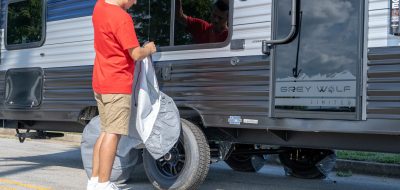 Exploring Wine Country in Your RV
Exploring Wine Country in Your RV
Wine. It’s been called the nectar of the Gods and nothing on earth—short of love—has spawned more poems, song lyrics, scripture mentions and panicky moments among restaurant diners.
As far back as recorded history, man has used wine to both survive and to celebrate life. During the Renaissance and during times of war and plague, wine was consumed when water was considered unsafe to drink. It’s included in religious ceremonies, used to toast special events and is a key component in fine cooking, both as an ingredient and an accompaniment. And, in recent years, scientists have discovered what Bacchus knew all along: red wine, when enjoyed in moderation, is actually good for your health.
Since we’re all for good health, consider lifting a glass to not only long life—yours—but to the enjoyment of that life. While a spicy red, a crisp white or that perfect amber-hued dessert wine can be located easily enough at your local wine shop or market, there’s something to be said for sourcing your own while out on the road.
There are more than 2,000 wineries in the continental United States—the vast majority of them open to the public at least a few days of the week—and finding that perfect Pinot Noir while exploring Oregon or uncorking a lovely Chenin Blanc while entertaining your dinner guests with the story of how you discovered it while cruising up the coast of Northern California can be an exciting addition to your time on the road.
A gentle reminder that while winery visits and subsequent wine tastings are the perfect way to discover new flavors, new friends and new insight on the crafting of one of life’s great pleasures, more than one or two glasses while exploring either calls for a designated driver or the parking of the RV and continued exploration by foot, bicycle or the use of a guided bus tour.
A Winery Visit
What each winery has to offer visitors will vary greatly based on locale, the winery’s size and even the time of the year you visit. Almost all wineries, regardless of size, will offer a tasting room where visitors can hear a bit about a particular vintage—the quality of the grape during a particular year, the difficulty surrounding a particular harvest, the scarcity of a particular grape that’s included in a blend, any awards that have been won—and where you can try multiple selections from that winery. Certainly most tasting rooms are aimed at retail sales; it’s the hope of the wine maker and winery owner that, after tasting a selection of their labels, you’ll pick up a bottle or two—or even a case or two—for your personal use at home.
Prices within the tasting room are sometimes a tad less expensive than what you’d pay for the same bottle at your local market and case prices often reflect savings of anywhere between 10% and 20% depending on the label and the demand for that particular vintage. Ordering a case for shipment— including a case that’s made up of a variety of the winery’s offerings—can typically be accomplished easily during a visit, provided there are no shipment issues to your home state and with the condition that there is someone at your home who is older than 21 to take physical delivery.
If you’re going to be continuing your vacation for a while, plan the shipment of your order accordingly; each state’s law varies as to what’s allowed in the shipment of alcoholic beverages but almost all states— and the delivery services who are responsible for the shipment—will require a signature for the delivery and will ask the signer for picture ID for proof of age. A thoughtful way to thank a neighbor, office mate or adult child for assisting you in the delivery process is to host a wine tasting upon your return.
More Than Wine
While all tasting rooms will provide the basics needed to sample the wine—the wines and necessary glasses, of course, but also typically crackers, bread or a similar non-salted item with which to cleanse or “erase” the palate in between tastings—many tasting rooms include additional retail items that can range from glasses and decanters bearing the winery’s logo to gourmet kitchen items, gourmet foods, wine-related accessories and apparel.
Picnic, Anyone?
Increasingly popular at the larger wineries that have expansive grounds are picnic areas adjacent to the tasting rooms with retail offerings including not only the winery’s own thirst-quenching product but lunch or snack items that might include everything from fully prepared box lunches to the wine-friendly pairings of cheese, baked goods and fruit.
Educational Opportunities
Some of the larger wineries—especially those in California and the Pacific Northwest—have created facility tours, wine cellars and even wine caves that are intended to educate as well as entertain. With many wineries only offering tours during specific times of the year or during scheduled times throughout the day, it’s always wise to check ahead of arrival for a tour that may interest you. See the accompanying article for multiple resources—websites, phone numbers and tour books—to find wineries along your route and to plan your visit. Visitor centers located in the general vicinity of the wine area you’re exploring can typically offer up-to-date information and will often offer to make a call and reserve tour space for your group at your request.
RV Accommodations
Individual wineries and visitor centers can often address any additional questions you might have about how to incorporate additional activities into your wine country visit or answer questions about the closest or best RV parks for your stay. Because of security and space issues, most wineries won’t allow an RV to stay on a property or in a parking lot overnight. Some wineries may not have sufficient parking space for a large RV just for a day visit, so if you will be visiting in your RV, it’s a good idea to call ahead and check on available parking. Wineries are a natural tourist destination, however, and since they are often clustered together because of the area’s unique growing conditions, RV parks are a natural extension of most tourist-friendly areas and can almost always be found within a few miles. This makes it convenient to park the RV at the campsite and use your tow vehicle or tow-behind car to visit the winery.
Another great option is guided winery tours that allow you to park your RV comfortably and to let someone else do the navigation and driving while you sit back and enjoy the opportunity to indulge in some wine tasting without the worries. All of the larger wine-making regions in the US—such as California’s Napa and Sonoma area, Oregon’s “Pinot Noir Trail,” California’s Mendocino Coast and Washington’s two wine growing regions—have dozens of local tour companies who specialize in winery tours and the kinds of activities that are often associated with wine regions such as hot air ballooning, horseback riding and the like. See the accompanying article for visitor’s centers and websites that can offer you choices unique to each locale.
According to Robert Louis Stevenson, “Wine is bottled poetry.” We couldn’t agree more and who couldn’t use a little more poetry—and the wine that inspires it—in their life? Cheers!





